
We officially have a kerfuffle on our hands.
Last week, Pandora stirred it up by publishing a colorful “white paper” that fires off a series of torpedoes aimed right at broadcast radio. It criticized everything from commercials, repetitive music, erosion among newer car owners, and – last but not least – the notion that AM/FM radio listeners are habitual button-punchers, limiting their exposure to commercials.
This is a central issue for radio because the car is the number one location for radio listening, automakers are working hard to change up the dashboard ecosystems in their vehicles, and mobile phones are becoming content gateways for drivers. What was once radio’s domain is now being chipped away by other sources, and that’s precisely the point Pandora is making – and then some.
But let’s go back to the beginning. It started with an Edison Research study, “Hacking the Commuter Code: What Really Happens When Consumers Are Driving.” Among other things, the study indicates that while commuting, AM/FM radio listeners push buttons an average of 22 times per journey, far higher than when listening to other sources (like streaming radio).
As we learned at DASH last fall, Pandora is working hard to bolster its automotive presence, from the dashboard to dealership. In the process, broadcast radio has new challenges on its hands. So when the Edison study was released, Pandora was quick to jump on this study with a provocative presentation of their own called “The State of In-Car Audio; New Insights on Today’s Commuters.” It liberally quoted the Edison data, including the conclusion that “streaming is the solution for reaching engaged drivers.”
Larry Rosin in his company’s blog pointed out some key stats that Pandora conveniently left out, including the fact that nearly three in ten commuters (29%) don’t switch stations when commercials come on. But the damage was done, and a series of outraged “first responders” in and around radio, including Pierre Bouvard, and Mary Beth Garber, were quick to refute many, if not all of Pandora’s claims. They quoted many different data sources, from Edison to a well-publicized IPSOS study in their defense of radio’s primary in the car.
Well, as it happens, we have a little data of our own. Our Techsurvey12 will be presented to its 200+ station stakeholders today, and then an executive summary will be shown to attendees of the Worldwide Radio Summit on Thursday. And as you might imagine, we asked versions of many of these same questions to the more than 39,000 respondents who took our survey.
So let’s first take a look at all the different sources consumers listen to while on the road. In Pandora’s “white paper,” they use the Edison slide below to make their point that “AM/FM radio has been joined by a great number of audio options.” No one argues that point, but at 90% usage, no one in broadcast radio (or its advertisers) would push back.
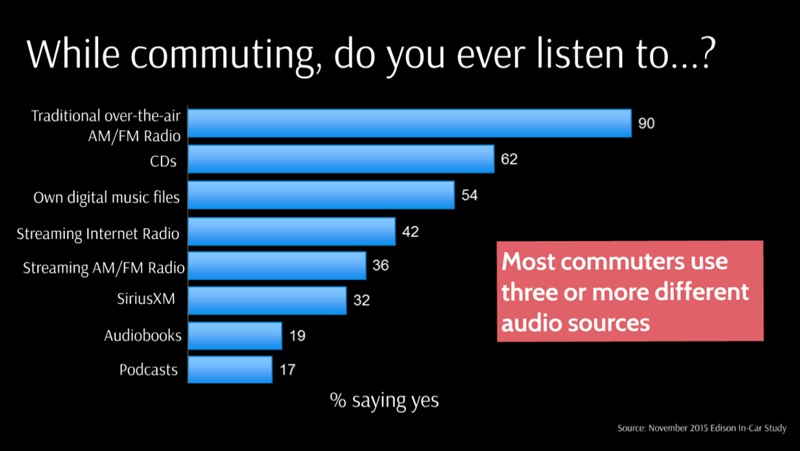
Even though the questions are similar, they are quite different. The Edison survey asks whether commuters ever listen to these sources. In TS12, we ask whether drivers and passengers use audio sources during an average weekday. Here’s the way our study breaks it down:
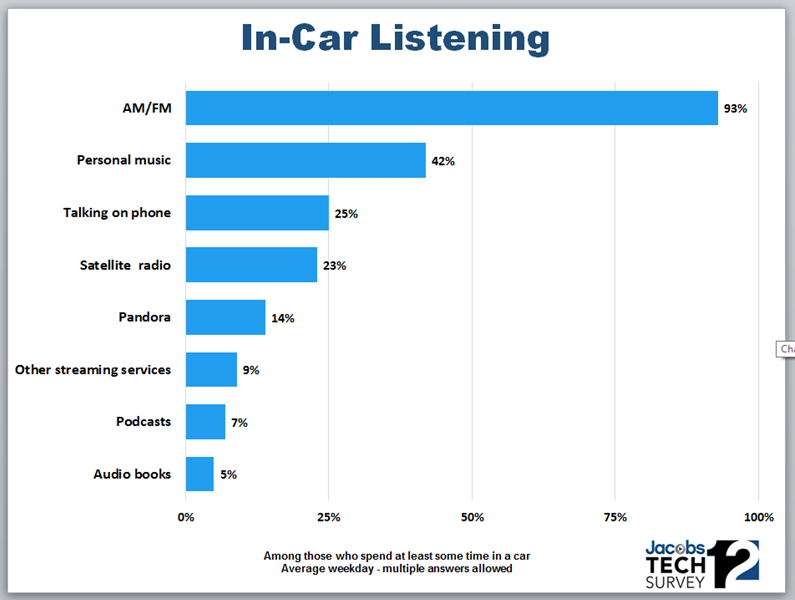
When it comes to AM/FM radio, the numbers are very close. In each of our studies, 9 of 10 listen to broadcast radio. But the big difference is in the way we treated internet radio. Edison lumps it all together, looking at streaming globally. In that format, four in ten commuters have ever listened to “streaming internet radio” while commuting.
Given the way Pandora sees its own brand as bigger than all the other pure-plays, we break them out separately in TS12. And our study shows that only 14% listen on an average day. So yes, radio has a 6x lead while people are on the road – a sizable advantage. Daily usage is important, especially to advertisers, and that’s why we use this wording.
We also ask our question a different way in order to get more granular about in-car listening. We ask our on-the-road respondents to assign a percentage to each of these sources that approximates their average day time spent with each medium, source, and activity. So think of these as shares, and our sample breaks down this way:
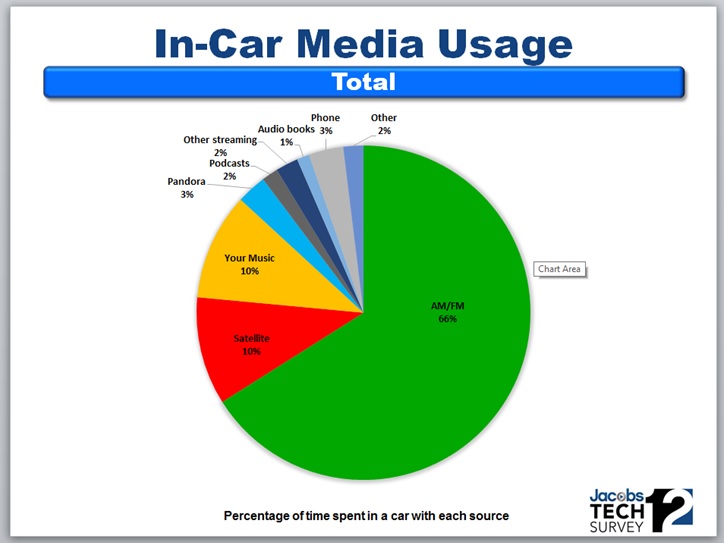
So AM/FM radio earns a very impressive 66% share of in-car listening, followed distantly by satellite radio and personal music (both with 10%), along with many other sources – including Pandora – at or around just 2-3%.
Now one of Pandora’s points is that as “connected car” ownership proliferates, streaming radio usage is going to go way up – and conversely, broadcast radio listening will greatly erode. As a company that is heavily invested in both the mobile and automotive space, we wanted to put this to the test as well.
In the slide below, we’ve isolated “connected car” owners to see how their in-car media usage varies from that of the total sample share above:
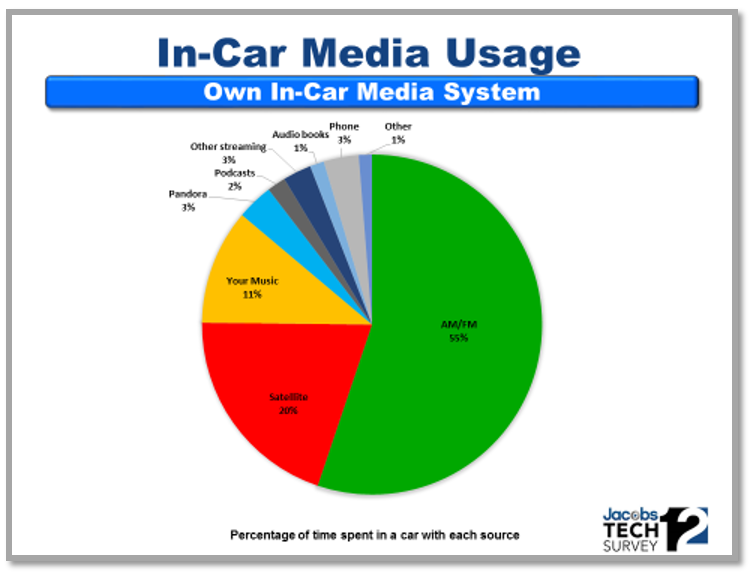 True enough, AM/FM radio takes a hit, dropping to a 55% share of in-car media usage. But it’s not Pandora that benefits – it’s satellite radio, doubling in share among those who drive cars that are fully connected.
True enough, AM/FM radio takes a hit, dropping to a 55% share of in-car media usage. But it’s not Pandora that benefits – it’s satellite radio, doubling in share among those who drive cars that are fully connected.
As for Pandora and other streaming sources, the differences – at least for now – are miniscule.
And one more data point to keep in mind revolves overall satisfaction among Pandora listeners – wherever and whenever they listen. Overall, our study reveals that while 27% of their audience say they’ve been listening more in the past year, 23% report less listening. And when we drilled down to better understand that behavior, we learned that for people listening less to Pandora, the following are the key impediments:
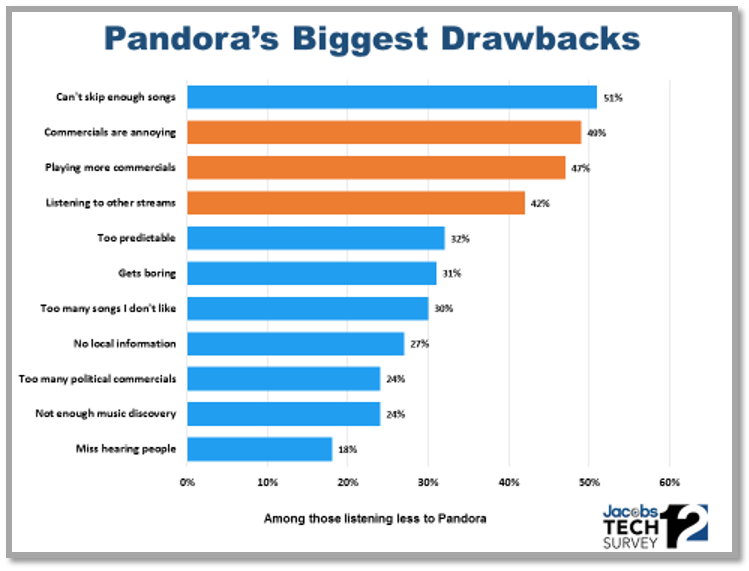 A lack of song skips is the biggest problem, cited by half of these disgruntled Pandora users. But annoying commercials and a perception that Pandora has increased their advertising represent major impediments to listening more.
A lack of song skips is the biggest problem, cited by half of these disgruntled Pandora users. But annoying commercials and a perception that Pandora has increased their advertising represent major impediments to listening more.
It’s noteworthy that while Pandora boasts of a more conducive commercial environment, particularly compared to broadcast radio, it’s a fact that advertising is not especially welcome content from pure-plays either.
And an additional drawback is that Pandora is now enduring what broadcasters have coped with since the early days: competition. Note that four of ten of those listening less to Pandora cite using other streaming sources, like Spotify.
The research knife cuts both ways. And in the case of Pandora (and other media outlets), they may find it just as rocky and arduous when it comes to successfully integrating advertising with the content.
A final note on whether people really listen to commercials – or not. When you ask respondents whether they actually hear ads or change the station, the reported or perceived result may be different than what actually occurs. In the case of the Edison study, nearly half say they tune out immediately or punch to something else in the middle of the first commercial while listening to AM/FM radio.
As an old advertising professor of mine used to point out when people would say “I never listen to (or watch) commercials,” somehow we all know what products to purchase when we walk down the aisle of a store. In one way or another, those insidious ads find a way to reach deep into our souls and into our purses and wallets.
Even on the radio.
Postscript: Techsurvey is comprised primarily of respondents who are members of radio station email databases. The Edison study is a national sample of solo auto commuters with journeys of more than 20 minutes each way.
- The Hazards Of Duke - April 11, 2025
- Simply Unpredictable - April 10, 2025
- Flush ‘Em Or Fix ‘Em?What Should Radio Do About Its Aging Brands? - April 9, 2025




Panning Pandora: Excellent. And, they certainly have a tune-out problem. LMAO. Thanks, Fred. http://www.broadcastideas.com
Back at you, Clark.
Great article and this information is not surprising. I’m probably the wrong guy to weigh in because I haven’t listened to the radio in over 5 years, but when I did, anytime a commercial came on I hit the little arrows on my wheel to switch stations. I’m guessing consumers listen to the radio to hear music or listen to a particular DJ and the commercials are irrelevant. Let’s pretend for a minute that in between your texting, talking on the phone, eating, drinking, applying make up, and shaving you actually catch a bit of an Ad that peaks your interest, your likely going to Google it anyway once you are stationary. I’ll end with this; if only 3 out of ten people stay on a station when a commercial comes on, then it doesn’t appear that the odds are in my favor if I’m trying to get a message out there!
Thanks for reading our blog and for the kind words. The advertising world (just like everything else) is being disrupted as well. While many consumers are online pretty much all the time, think about the last time you clicked a banner ad. Getting attention is a challenge, and while radio creative needs a complete overhaul, live reads, creative packaging, and integrating digital assets with radio’s massive on-air reach can generate revenue for savvy advertisers.
I still think radio is a good way to drive people with a good schedule, creative spots, and worthwhile CTA.
Meanwhile, technology is changing the types of ads people will tolerate and consume – so radio will obviously take hits.
I see a combo of the two as a win… such as using radio to drive people to cool experiences like this Virtual Reality musical (it’s a practice session / choreography test, but you get the idea).
https://bit.ly/SlappyTest
Randall, thanks for the comment. As you point out, one of radio’s great strengths is its ability to generate an action, including checking our a VR experience like the kind you linked. BTW we blogged about KCRW’s virtual reality project in a post earlier in the year, a great example of what you’re talking about. KCRW VR
When I saw the Edison Research suggesting the “average commuter” changes the station 22 times I noticed the distinct smell of B.S. fill the room. Pandora is clutching at straws and STILL trying to come up with a business model that can actually make money. My best suggestion for Pandora is that they merge/sell to either iHeart or Cumulus, so they can achieve “the economy of scale” to become profitable! Sorry, I couldn’t resist!!
I totally get it, Charlie. I won’t get into the voracity of the Edison research, so if Larry would like to comment, he is more than welcome. Our study is conducted among radio listeners, but that said, I stand behind the heft of our sample and the results. Thanks for chiming in.
Me also thinks the Pandora folks doth protest too much, Fred. There seems to be an air of desperation in how they have pounced on these results. And you may be pleased to know that your “little bit of data” on in-car listening line up closely with what we see among Canadian drivers/passengers (not just radio listeners). The share of in-car listening devoted to AM/FM radio in the previous 24 hours stands at 66% This share drops to 59% among those who indicate they have some kind of “connected car” technology. The difference? Satellite radio, which has a 16% share among those with ‘connected car’ technology vs. 9% among drivers/passengers in general. We see no other differences in any other audio sources.
Jeff, glad to hear there’s so much consistency between what you’re seeing in your “pure” Canadian research, and what we’ve produced in TS12. Appreciate the comment.
Nice piece Fred…and you are right the research cuts both ways. Good of them to cherry pick and leave a few facts out. They should consult political campaigns. lol hope to see you next go ’round in Philly!
Appreciate the kind words you reading our blog, Tony.
This week feels like a boxing match over the present and future of in-car listening. I think that if we consolidate general points from these studies we arrive at violent agreement:
1) Listeners dislike commercials. One way or another they tune away from them.
2) Listeners like personalized content. They skip or tune away from badly matched music and commercials.
3) Ease-of-use influences use.
In this framework, terrestrial has important advantages: It is built into all cars; average car is 11-12 years old so radio is easy to operate; you don’t need to establish an account; it has personality that people get attached to.
The future will definitely challenge radio in the car. The radio trades encourage complacency (not you, Fred) because today’s reach is outstanding. In 11-12 years it will be harder to find radio in the average car, and easier to find personalized streams. That is categorically true, and a rare example of a demonstrable trend moving slowly enough to plan for. Cyclical disruption has never been more obvious or leisurely.
It’s really not about liking/disliking Pandora, praising/criticizing Pandora, or about how Pandora chooses which metrics to flaunt. Those are details. The digital content revolution is about personalization. Whether Pandora succeeds or fails, personalization will win, because it will increasingly be easy for consumers to understand it and choose it. Switching stations (whether terrestrial or stream) is just today’s easiest in-car method of personalization, when the source is doing a poor job of it.
(PS: I love radio, and always have.)
Brad, I’m gratified the post stimulated this high level of thinking. Your comments are spot-on. I look at your conclusion, however, a little differently. Yes, personalization matters, but to my mind, it’s about what kind of experience each provides. And while radio may not be able to provide that moment to moment personalization, the ability to surprise on the one hand, or be a great storyteller are what sets great radio apart. The next bunch of years for radio in the dash could get gnarly, another reason why we’re continuing to bring up the notion that programmers aren’t just competing against each other – they now are up against everything a consumer get port into a car from their smartphones. Thanks, Brad, for elevating the conversation.
Fred, I agree. Personalization is experience. It gets personal when people like it! Cheers.
Great article Sir i will share this article Car Audio with my friends
Great article Sir i will share this article Car Audio with my friends